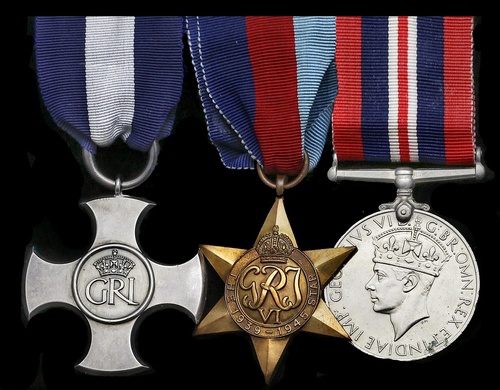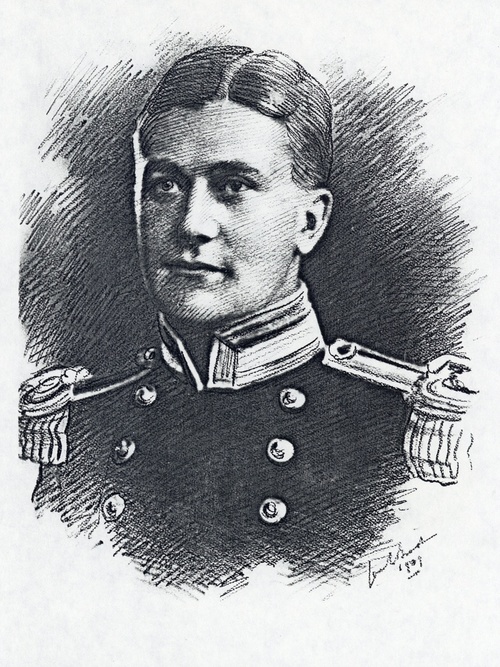Auction: 17002 - Orders, Decorations and Medals
Lot: 327
'H.M.S. Esk performed a rescue that, standing by itself in time of peace, would have covered the front pages of the newspapers of the world.'
A. D. Divine's Dunkirk, refers.
A poignant Second World War Dunkirk D.S.C. group of three attributed to Lieutenant C. W. Carter, Royal Navy, who was decorated for his gallant rescue work as H.M.S. Esk embarked survivors from the S.S. Scotia during a bombing attack on 1 June 1940: he was killed less than three months later when Esk ran into a minefield off Texel
Distinguished Service Cross, G.VI.R., hallmarks for London 1940, the reverse officially dated '1940' and privately engraved, 'Lieut. Clifford W. Carter, R.N., H.M.S. Esk, Dunkirk'; 1939-45 Star; War Medal 1939-45, good very fine or better (3)
D.S.C. London Gazette 16 August 1940:
'For good services in the withdrawal of the Allied Armies from the beaches at Dunkirk.'
The original recommendation states:
'For outstanding ability, devotion to duty and bravery in saving life when embarking troops from S.S. Scotia during a bombing attack. His personal courage on several occasions was a fine example.'
Clifford Woodruff Carter entered the Royal Navy as a cadet in the late 1920s and was appointed to the acting rank of Sub. Lieutenant in May 1930. Advanced to Lieutenant in in the summer of 1933, he was serving as 'Jimmy the One' in the destroyer H.M.S. Esk at the outbreak of hostilities in September 1939. As part of the 20th Destroyer Flotilla, Esk was quickly employed on mine-laying operations off the Dutch and Norwegian coasts but in late May she was ordered to Dover in support of Operation "Dynamo".
Esk's subsequent part in that memorable operation is best summarised by the recommendation for the D.S.C. awarded to her captain, Lieutenant-Commander R. J. H. Crouch, R.N.:
'Esk made six trips, three of them to Bray beach, during the period 28 May to 3 June 1940, and brought to Dover about 4,500 troops. On 31 May, off Bray, she was forced, by shell fire from the shore batteries, to move westward along the beach, Esk being holed in several places and having one oil tank pierced. She was also subjected to bombing attacks on passage back to Dover, but avoided damage by the use of speed and zig-zagging. On 1 June she again avoided damage off the entrance to Dunkirk by circling at 20 knots and when attacked later whilst taking survivors off S.S. Scotia, she drove off two bombers by the fire of 'B' and 'X' guns.'
Gallant rescue under attack
In his official report of events on Saturday 1 June 1940, the Scotia's Master paid tribute to the gallant work undertaken by Esk's crew:
'Commander Crouch of H.M.S. Esk received our S.O.S. He was lying at Dunkirk at the time; he came at full speed to the rescue. By now the boat deck starboard side was in the water and the vessel was going over. He very skilfully put the bow of his ship close to the forecastle head, taking off a large number of troops and picking up hundreds out of the sea. Backing his ship out again, he came amidships on the starboard side, his stem being now against the boat deck, and continued to rescue survivors.
The Scotia had now gone over until her forward funnel and mast were in the water. Two enemy bombers again approached us dropping four bombs and machine-gunning those swimming and clinging to wreckage. The Esk kept firing and drove the enemy away. Commander Crouch again skilfully manoeuvred his ship around to the port side, the Scotia having gone over until the port bilge keel was out of the water. Hundreds of soldiers were huddled on the bilge and some of them swam to Esk, while others were pulled up by ropes and rafts.
The bombers returned but were driven away by heavy firing from the Esk. I was informed that one of my crew who was on the destroyer that one of these two bombers had been brought down by Esk.
Rescue work continued. Large numbers of troops who had climbed up on the bilge were comparatively easily rescued. Others swam to the nets attached to the destroyer where willing hands were ready to haul them up. These nets were a very great help. By this time, all who were able to help themselves had left the wreck, but there were three lying seriously wounded. One of them was a steward of the Scotia, the other two being French soldiers. A rope was thrown from the destroyer; I tied this around the steward and by means of a boat fall lying across the side of the Scotia I was able, by holding onto it, to ease the jerk in the water and against the side of the destroyer. He was very badly injured but he was very patient and never grumbled. I learn that he has since had one leg amputated. The two French soldiers were rescued in the same way. Having assured myself that everyone who was still alive had been taken off, a boat spar was swung from Esk on to the Scotia, by which I climbed aboard the Esk. The destroyer landed the survivors at Dover.
Many other survivors had been picked up by boats from another transport and other craft which were in the vicinity and were landed in different ports.
I regret deeply to report our final list showed 28 of our crew missing and two others have since died in hospital, while several are lying injured in hospitals. I estimate that between 200 and 300 troops must have lost their lives.
May I warmly thank the Commander of the Esk for his skilful work which was the means of saving many hundreds of lives.'
Journey's end
On the last day of August 1940, Esk and her consorts of the 20th Destroyer Flotilla sailed for the Dutch coast on a minelaying mission. Just north of Texel, Express hit a mine which tore off part of her bow and Esk closed to assist. Almost immediately Esk also hit a mine and, some 15 minutes later, she was torn in two by a massive explosion amidships. The Ivanhoe picked up a few survivors and 25 others were taken prisoner but Carter was not among them.
Aged 30 years, he was the son of Francis Neville and Mabel Carter of Newport, Monmouthshire. He has no known grave and is commemorated on the Portsmouth Naval Memorial; sold with copied research, including a portrait of the recipient.
Additional reference sources:
Divine, A.D., D.S.M., Dunkirk (Faber & Faber, London, 1944).
Lord, Walter, The Miracle of Dunkirk (Allen Lane, London, 1983).
Subject to 20% VAT on Buyer’s Premium. For more information please view Terms and Conditions for Buyers.
Sold for
£1,200







